Answered step by step
Verified Expert Solution
Question
1 Approved Answer
please answer and explain in your own words. thank you!!! Q: SWOT ANALYSIS and Evaluation - This case discusses a marketing research study conducted on
please answer and explain in your own words. thank you!!! 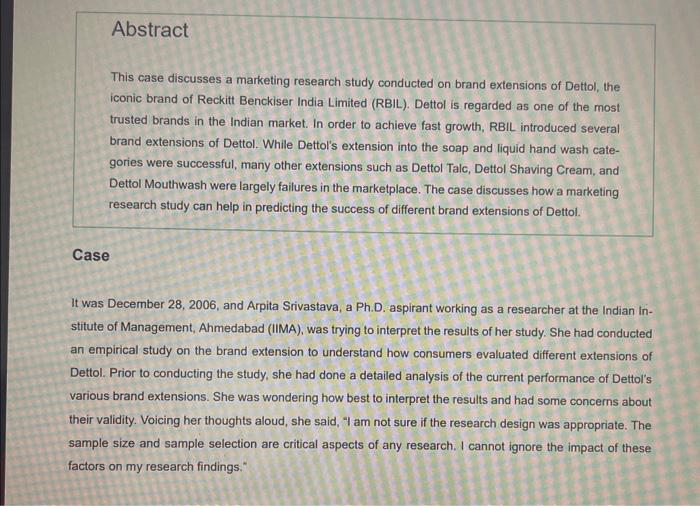

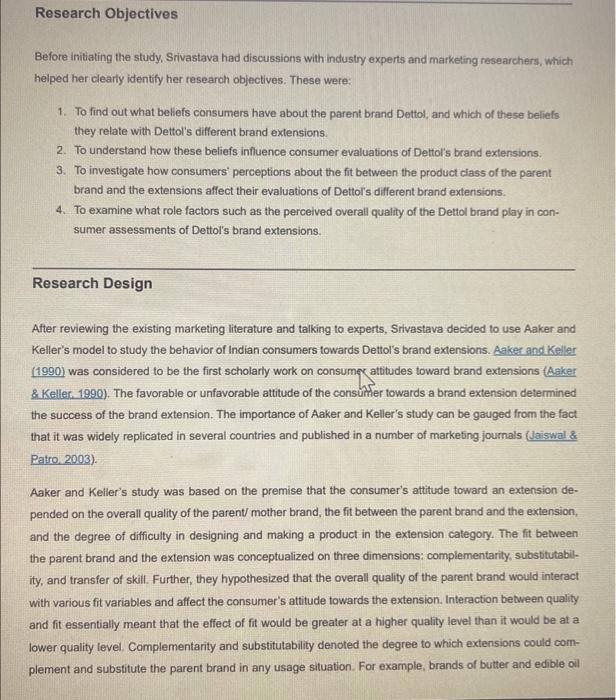
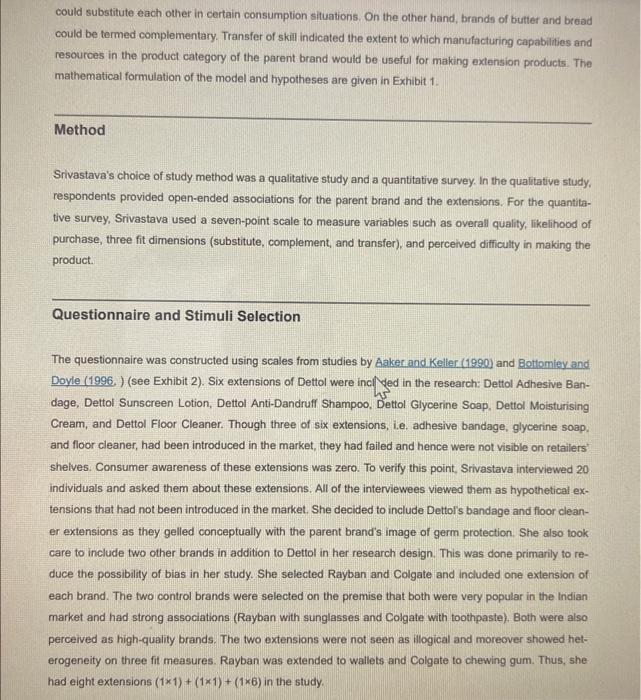
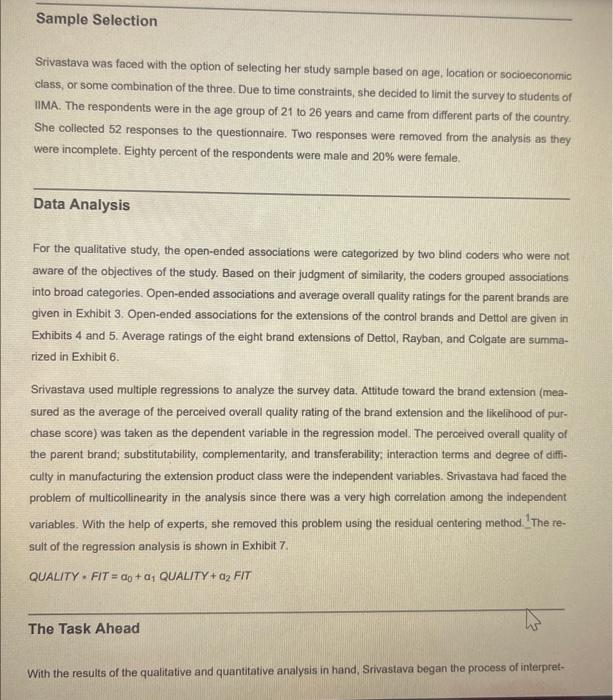
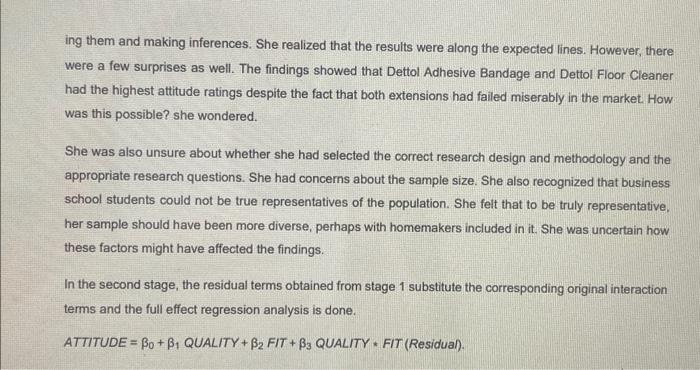
This case discusses a marketing research study conducted on brand extensions of Dettol, the iconic brand of Reckitt Benckiser India Limited (RBIL). Dettol is regarded as one of the most trusted brands in the Indian market. In order to achieve fast growth, RBIL introduced several brand extensions of Dettol. While Dettol's extension into the soap and liquid hand wash categories were successful, many other extensions such as Dettol Talc, Dettol Shaving Cream, and Dettol Mouthwash were largely failures in the marketplace. The case discusses how a marketing research study can help in predicting the success of different brand extensions of Dettol. Case It was December 28, 2006, and Arpita Srivastava, a Ph.D. aspirant working as a researcher at the Indian Institute of Management, Ahmedabad (IIMA), was trying to interpret the results of her study. She had conducted an empirical study on the brand extension to understand how consumers evaluated different extensions of Dettol. Prior to conducting the study, she had done a detailed analysis of the current performance of Dettol's various brand extensions. She was wondering how best to interpret the results and had some concerns about their validity. Voicing her thoughts aloud, she said, 1 am not sure if the research design was appropriate. The sample size and sample selection are critical aspects of any research. I cannot ignore the impact of these factors on my research findings." Brand Extensions of Dettol Detto make a mark in the market placeself in consumers' minds since its launch in the 1930 s. As a brand, it enjoyed a high level of customer loyalty and trust. With the objective of achieving rapid growth, Reckitt Benckiser India Limited (RBIL) introduced several brand extensions. Instead of launching entirely new brands, RBIL wanted to exploit Dettol's brand equity. While the company successfully extended the Dettol brand into the soap and liquid hand wash categories, a number of other extensions such as Dettol Talc, Dettol Shaving Cream, and Dettol Mouthwash failed to make a mark in the marketplace ( Jaiswal et al. 2007). . Research Objectives Before initiating the study, Srivastava had discussions with industry experts and marketing researchers, which helped her clearly identify her research objectives. These were: 1. To find out what beliefs consumers have about the parent brand Dettol, and which of these beliefs they relate with Dettol's different brand extensions. 2. To understand how these beliefs influence consumer evaluations of Dettol's brand extensions. 3. To investigate how consumers' perceptions about the fit between the product ciass of the parent brand and the extensions affect their evaluations of Dettol's different brand extensions. 4. To examine what role factors such as the percelved overall quality of the Dettol brand play in consumer assessments of Dettol's brand extensions. Research Design After reviewing the existing marketing literature and talking to experts, Srivastava decided to use Aaker and Keller's model to study the behavior of Indian consumers towards Dettol's brand extensions. Aaker and Keller (1990) was considered to be the first scholarly work on consume attitudes toward brand extensions (Aaker \& Keller, 1990). The favorable or unfavorable attitude of the consunter towards a brand extension determined the success of the brand extension. The importance of Aaker and Keller's study can be gauged from the fact that it was widely replicated in several countries and published in a number of marketing journals (Jaiswal \& Ratro, 2003). Aaker and Keller's study was based on the premise that the consumer's attitude toward an extension depended on the overall quality of the parent/ mother brand, the fit between the parent brand and the extension, and the degree of difficulty in designing and making a product in the extension category. The fit between the parent brand and the extension was conceptualized on three dimensions: complementarity, substitutability, and transfer of skill. Further, they hypothesized that the overall quality of the parent brand would interact with various fit variables and affect the consumer's attitude towards the extension. Interaction between quality and fit essentially meant that the effect of fit would be greater at a higher quality level than it would be at a lower quality level. Complementarity and substitutability denoted the degree to which extensions could complement and substitute the parent brand in any usage situation. For example, brands of butter and edible oil could substitute each other in certain consumption situations. On the other hand, brands of butter and bread could be termed complementary. Transfer of skill indicated the extent to which manufecturing capabilities and resources in the product category of the parent brand would be useful for making extension products. The mathematical formulation of the model and hypotheses are given in Exhibit 1. Method Srivastava's choice of study method was a qualitative study and a quantitative survey, In the qualitative study. respondents provided open-ended associations for the parent brand and the extensions. For the quantitative survey, Srivastava used a seven-point scale to measure variables such as overall quality, likelihood of purchase, three fit dimensions (substitute, complement, and transfer), and perceived difficulty in making the product. Questionnaire and Stimuli Selection The questionnaire was constructed using scales from studies by Aaker and Keller (1990) and Botlomley and Doyle (1996, ) (see Exhibit 2). Six extensions of Dettol were inci ded in the research: Dettol Adhesive Bandage, Dettol Sunscreen Lotion, Dettol Anti-Dandruff Shampoo, Dettol Glycerine Scap, Dettol Moisturising Cream, and Dettol Floor Cleaner. Though three of six extensions, i.e. adhesive bandage, glycerine soap. and floor cleaner, had been introduced in the market, they had failed and hence were not visible on retailers: shelves. Consumer awareness of these extensions was zero. To verify this point, Srivastava interviewed 20 individuals and asked them about these extensions. All of the interviewees viewed them as hypothetical extensions that had not been introduced in the market. She decided to include Dettor's bandage and floor cleaner extensions as they gelled conceptually with the parent brand's image of germ protection. She also took care to include two other brands in addition to Dettol in her research design. This was done primarily to reduce the possibility of bias in her study. She selected Rayban and Colgate and included one extension of each brand. The two control brands were selected on the premise that both were very popular in the Indian market and had strong associations (Rayban with sunglasses and Colgate with toothpaste), Both were also perceived as high-quality brands. The two extensions were not seen as illogical and moreover showed heterogeneity on three fit measures. Rayban was extended to wallets and Colgate to chewing gum. Thus, she had eight extensions (11)+(11)+(16) in the study. Sample Selection Srivastava was faced with the option of selecting her study sample based on age, location or socioeconomic class, or some combination of the three. Due to time constraints, she decided to limit the survey to students of IIMA. The respondents were in the age group of 21 to 26 years and came from different parts of the country. She collected 52 responses to the questionnaire. Two responses were removed from the analysis as they were incomplete. Eighty percent of the respondents were male and 20% were female. Data Analysis For the qualitative study, the open-ended associations were categorized by two blind coders who were not. aware of the objectives of the study. Based on their judgment of similarity, the coders grouped associations into broad categories. Open-ended associations and average overall quality ratings for the parent brands are given in Exhibit 3. Open-ended associations for the extensions of the control brands and Dettol are given in Exhibits 4 and 5. Average ratings of the eight brand extensions of Dettol, Rayban, and Colgate are summarized in Exhibit 6 . Srivastava used multiple regressions to analyze the survey data. Attitude toward the brand extension (measured as the average of the perceived overall quality rating of the brand extension and the likelihood of purchase score) was taken as the dependent variable in the regression model. The perceived overall quality of the parent brand; substitutability, complementarity, and transferability; interaction terms and degree of difficully in manufacturing the extension product class were the independent variables. Srivastava had faced the problem of multicollinearity in the analysis since there was a very high correlation among the independent variables. With the help of experts, she removed this problem using the residual centering method. 1 The result of the regression analysis is shown in Exhibit 7. QUALITY =FIT=0+a1QUALITY+a2FIT The Task Ahead With the results of the qualitative and quantitative analysis in hand, Srivastava began the process of interpret- ing them and making inferences. She realized that the results were along the expected lines. However, there were a few surprises as well. The findings showed that Dettol Adhesive Bandage and Dettol Floor Cleaner had the highest attitude ratings despite the fact that both extensions had failed miserably in the market. How was this possible? she wondered. She was also unsure about whether she had selected the correct research design and methodology and the appropriate research questions. She had concerns about the sample size. She also recognized that business school students could not be true representatives of the population. She felt that to be truly representative, her sample should have been more diverse, perhaps with homemakers included in it. She was uncertain how these factors might have affected the findings. In the second stage, the residual terms obtained from stage 1 substitute the corresponding original interaction terms and the full effect regression analysis is done. ATTITUDE =0+1 QUALITY +2FIT+3 QUALITY * FIT (Residual) Q: SWOT ANALYSIS and Evaluation
-






Step by Step Solution
There are 3 Steps involved in it
Step: 1

Get Instant Access to Expert-Tailored Solutions
See step-by-step solutions with expert insights and AI powered tools for academic success
Step: 2

Step: 3

Ace Your Homework with AI
Get the answers you need in no time with our AI-driven, step-by-step assistance
Get Started


